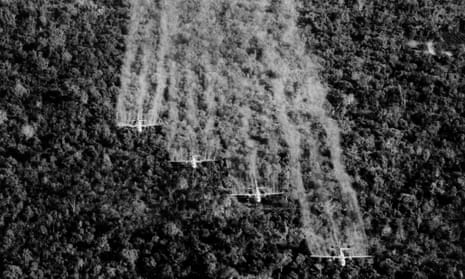US air force reservists who did maintenance on C-123 aircraft used during the Vietnam war to spray the defoliant Agent Orange could have been exposed to harmful levels of dioxin even long after the conflict, the health arm of the National Academy of Sciences said on Friday.
A panel from the Institute of Medicine acknowledged the poor quality of sampling data available from the planes used in Operation Ranch Hand in Vietnam, but concluded that air force reservists who maintained the contaminated planes long after the conflict could have increased risk of health problems.
The study, requested by the Department of Veterans Affairs, could influence how health compensation claims from the maintenance workers are handled under the Agent Orange Act of 1991. Previously, claims had been rejected for those who worked on the aircraft after the war and had no experience in Vietnam.
Between 1972 and 1982, as many as 2,100 air force reserve personnel trained and worked on C-123 aircraft that had been used to spray Agent Orange during the Vietnam war, the panel said. After the Agent Orange Act was passed, some reservists lodged health claims with the VA.
Data on contamination of C-123s used in Vietnam was skimpy, the panel found. Officials have been unable to determine exactly how many C-123s the military used in Vietnam and how many of those were used to spray the defoliant.
Sampling for contamination on several planes was not conducted until well after the war, it said.
But the panel noted that previous assessments from those in the military or the VA minimised the health risk of exposure, often saying any Agent Orange residues on the interior surfaces could not have moved from their location and endangered humans.
The panel flatly rejected that idea, saying it is well accepted now that semi-volatile organic compounds like those in Agent Orange remain in “dynamic flux” in enclosed spaces.
“Accordingly, the committee states with confidence that the AF [air force] reservists were exposed when working in the ORH [Operation Ranch Hand] C-123s and so experienced some increase in their risk of a variety of adverse responses,” it said.
The panel said that while there were few samples from the interior of C-123s used to spray Agent Orange, those that did so fell in a range “meriting cautionary consideration” under international guidelines for exposure.
Agent Orange was produced for the US military by a number of companies, including Dow Chemical, Monsanto and others. Seven companies settled a class action lawsuit in 1984 by paying $180m into a victims compensation fund. The fund closed in 1997, but legal battles against the companies have continued.

Comments (…)
Sign in or create your Guardian account to join the discussion